Transactional email v.s Marketing email: A Definitive Guide
We are all too familiar with marketing emails, which fill up our inboxes on a regular basis. However, a new type of email has recently emerged known as “transactional email.” What is the distinction between marketing and transactional email? It may seem that they both refer to the same thing - emails sent by corporations to end users. That definition is not incorrect; however, it is only a broad explanation for the concepts. In this article, I will share with you everything you need to know about the differences between transactional emails and marketing emails. Let’s jump right into the details!
What are the differences between transactional and marketing emails?
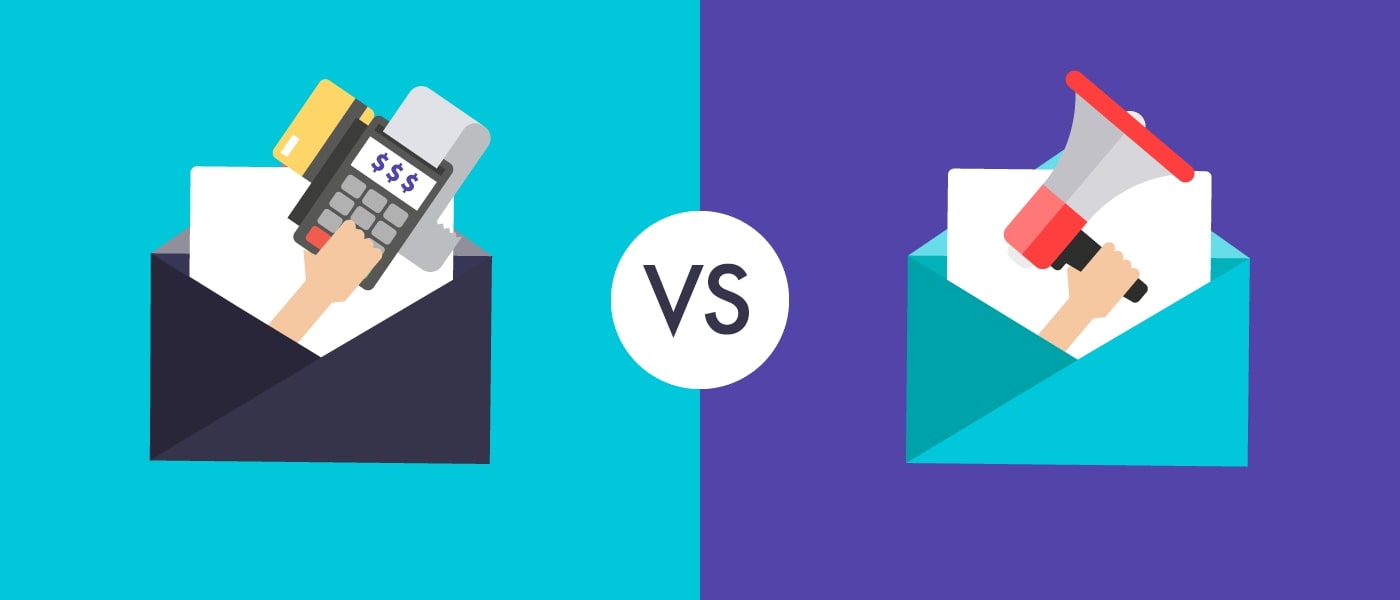
First offs, let’s have a quick look at the definition of the two types of email.
- Transactional emails. Transactional emails include information that is specific to each receiver. They are typically prompted by a user action on a website or app, and they prompt people to finish a transaction or procedure, such as password resets. However, they can also be solely informative, such as monthly statements. They intend to strengthen an existing consumer relationship.
- Marketing emails. Marketing emails are also known as commercial emails as they contain marketing and promotional information. They are meant to do things such as encourage a recipient to make a purchase or download information. They are strategically provided at a predetermined moment to a list of prospects or customers who have opted in to get additional information.
The important distinction is that transactional emails are sent one-to-one, and as a result, they have greater open rates than marketing emails, which are delivered one-to-many. Automation is used in both transactional and marketing email to distribute emails based on a predetermined trigger or event.
6 Types of transactional emails
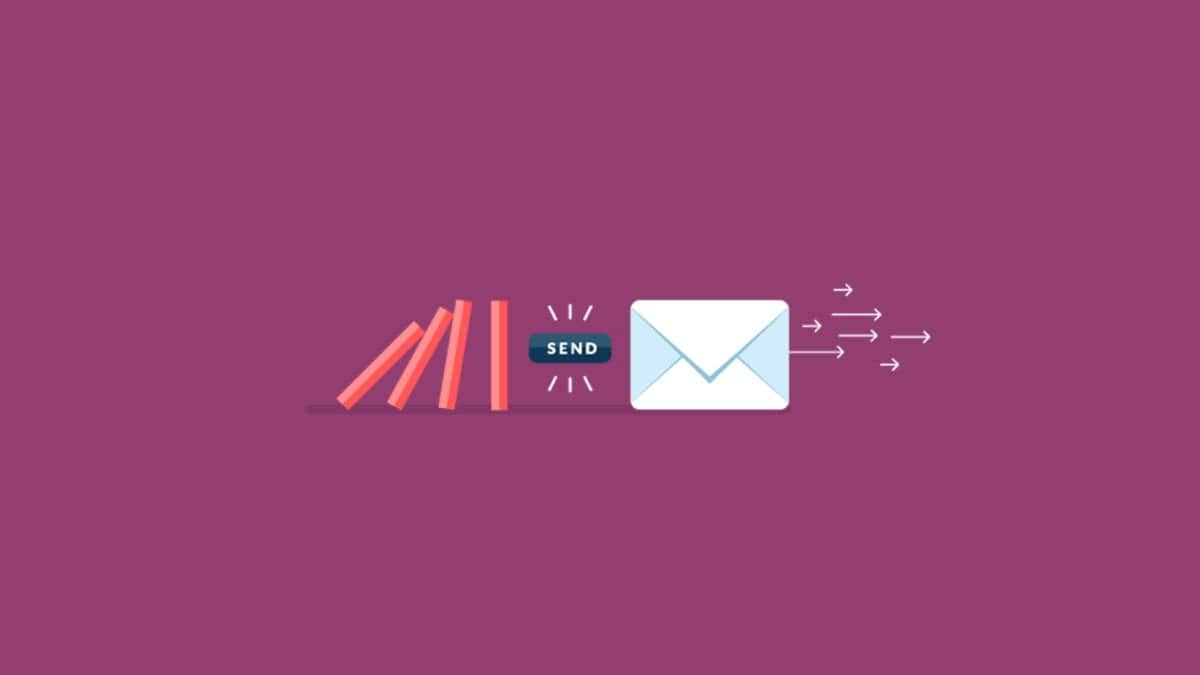
You can distinguish between transactional and marketing emails via the types of emails you send out. In the following section, we’ll go over the most common types of transactional emails:
1. Email Address Confirmation/Registration Emails
Confirmation emails are when you send an email to confirm a buyer’s activity, such as order confirmation, fill out a form, or register for an event or webinar on your website, if they subscribe to your newsletter. This improves the customer experience and establishes the foundation for a trusted relationship. These emails can also be used as a double opt-in for subscribers to validate their email address. Some companies do this to ensure that subscribers provide authentic email addresses, which is an excellent approach to keep your database clean.
Confirmation and registration emails are also excellent opportunities to give your subscribers additional information they may require, such as your contact email, phone number, or social media profiles, and it allows them to connect with you in a variety of ways. Best Buy’s welcome email, for example, includes several calls-to-action (CTAs) to assist users discover more about their various services.

2. Password Resets
If your website includes a login gateway, make sure that when your subscribers request a password change, they receive fast, tailored, and clear information on how to reset their password. Furthermore, given the popularity of phishing operations, including a website or email address where users can report unwanted password requests boosts your trust.
This email from Treehouse includes detailed instructions on how to do a password reset, an alternate link, and a contact email in case of any complications.
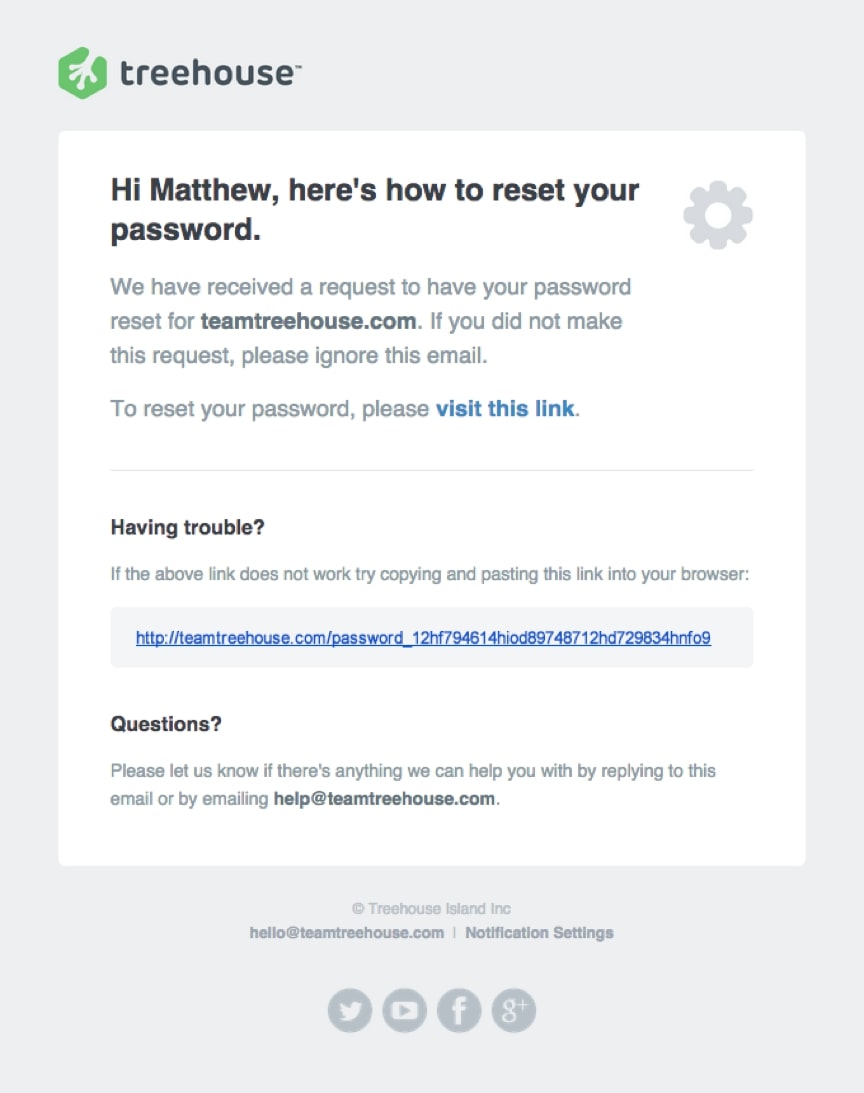
3. Order Confirmation Emails and Purchase Receipts
Follow up on your customer with an email that confirms their order and gives their shipping details and tracking links, if relevant, when they make a purchase or register for a conference.
Buyers are frequently eager to check their order confirmation since it reassures them that their transaction was processed and informs them when they will get their goods. Fitbit’s order confirmation email contains a receipt as well as a link to check the order status in real time.
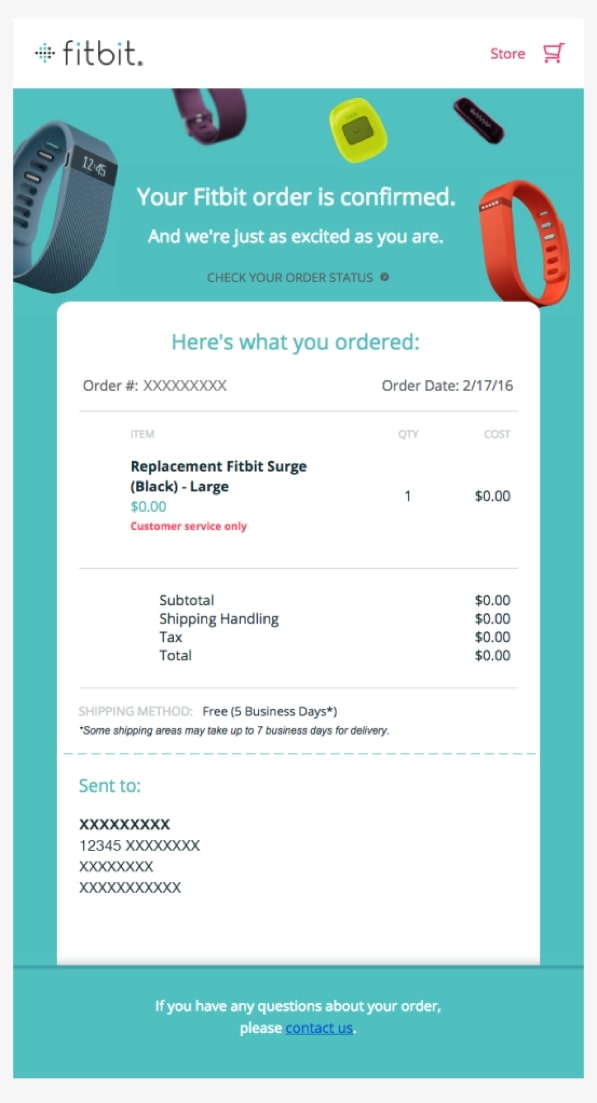
Use your subscriber’s level of engagement to your advantage by displaying customer testimonials or cross-selling relevant products, services, or events. According to Experian, transactional emails that include cross-sell products have a 20% greater transaction rate than those that do not. Within the email, ask for references.
You can also use order confirmation emails to solicit referrals from your subscribers. Skillshare, for example, adds a referral link at the bottom of their receipts to encourage users to suggest friends.
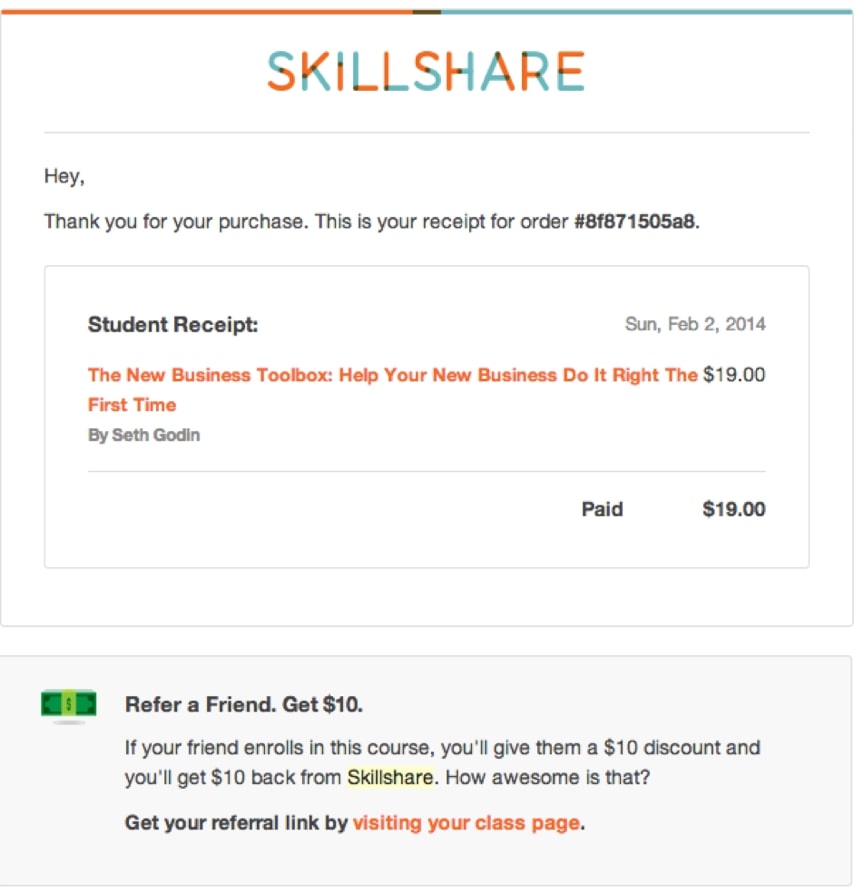
4. Feedback Emails
There is always room for improvement, and understanding how your consumers feel is one of the finest methods to improve the client experience. Directly solicit comments from your subscribers based on the appropriate circumstances (e.g. after they book a trip from your website or 3-months into their software subscription).
Because their comments can be lengthy, you may want to include a call to action to a landing page to gather it. For example, following a game, the Arkansas Razorbacks send participants an email thanking them for their attendance, reviewing the scorecard, and referring them to a link to complete a survey on their experience.
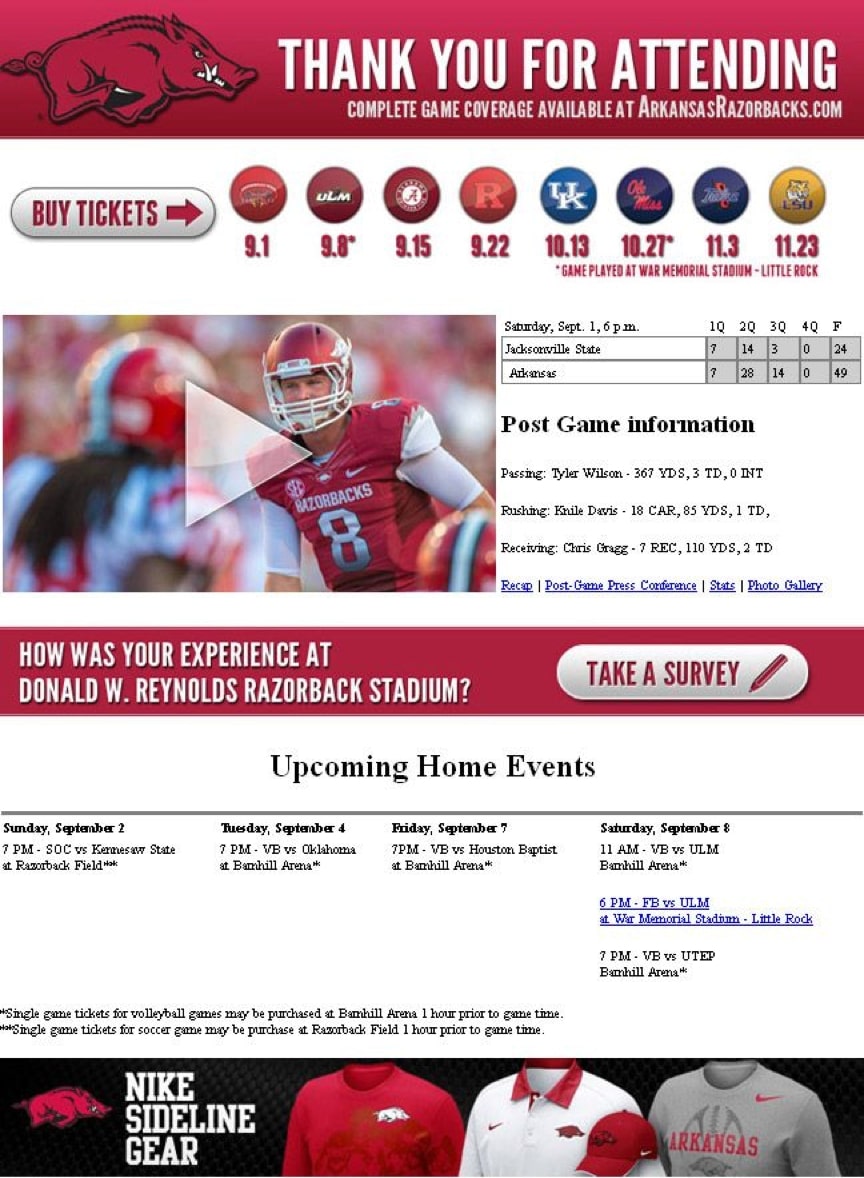
5. Reactivation Emails
Subscribers who have previously communicated with the brand but have not continued to engage are sent reactivation emails. This might include shoppers who exit their shopping cart without purchasing, email subscribers who haven’t been checking your communications, or established customers whose subscriptions are about to expire.
Offers should be tailored to each subscriber’s behavior and purchasing stage (e.g. send more attractive offers to subscribers with a lower level of engagement or existing customers who are likely to churn).
Reactivation emails are an excellent approach to keep your brand at the forefront of your subscribers’ minds and to remind them of the value your brand delivers. You can use a comical approach, like Bonobos, or send a direct, to-the-point email, like Apple Music.
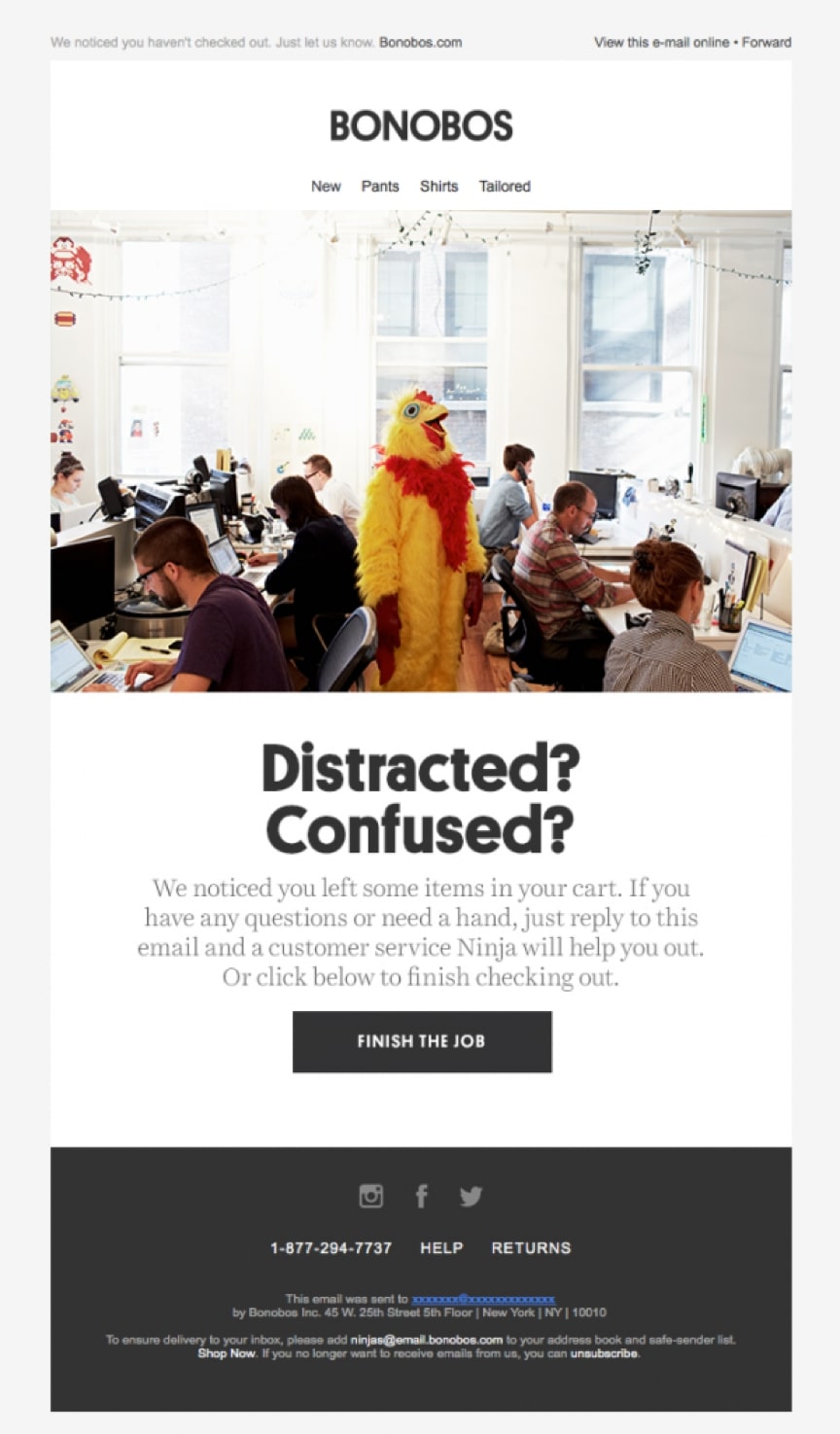

6. Website/App Extension Emails
Improve engagement by bridging the gap between your various channels. Subscribers can interact with you on their preferred device by including in-email functionality that connects to your website or app. LinkedIn, for example, sends a CTA email when you receive a new personalized LinkedIn invitation and prompts the user to confirm the request.
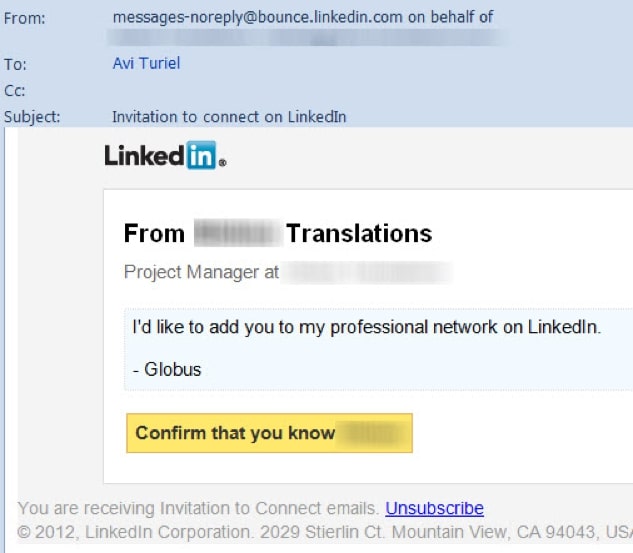
Transactional emails, regardless of industry, can help you earn more income, increase brand loyalty, and enhance email deliverability.
8 Types of marketing emails
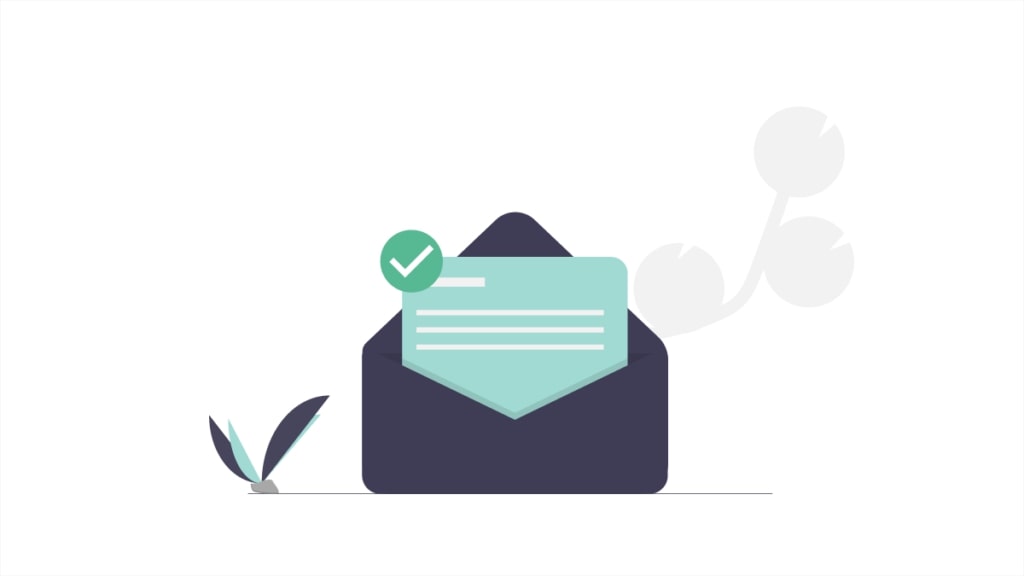
After we have gone through the most common types of transactional emails, now let’s move on to the most common types of marketing emails. Understanding the difference between these two types of emails will help you know when to send which.
1. Welcome email series
Sending a welcome email to a new subscriber is the most effective approach to communicate with them. When someone visits your website and subscribes to your newsletter, they are giving you permission to contact them.
Welcome emails have also been shown to be effective. According to studies, welcome emails have an 86 percent greater open rate than other types of marketing emails. Perhaps this is due to the fact that 74% of new subscribers anticipate to get a welcome email shortly after subscribing to a newsletter.
Sending these types of emails gives you the opportunity to establish an immediate connection with the subscriber. This would result in improved email engagement and response rates in the future. A welcome email is also useful for informing subscribers about what they may expect from you in the future. This is an example of a fantastic Airbnb welcome email:

This email demonstrates everything Airbnb has to offer right away. It answers all of your queries by offering a clear outline of their objective. The following features are clearly displayed in the email:
- Find a home
- Explore experiences
- Become a host.
This email demonstrates everything Airbnb has to offer right away. It answers all of your queries by offering a clear outline of their objective. The email clearly displays the features that Airbnb provides. Another bonus is that the email is well-designed. The images are appealing, and the messaging is peppered with pertinent CTAs.
Consider the following when writing your welcome email:
- Thank them for subscribing
- Demonstrate what you have to offer.
- Include a freebie to entice them to interact with your material.
2. The standard newsletter
Most businesses believe that email newsletters are out of date and require a significant amount of work. Subscribers may believe that newsletters are primarily promotional and give no value. Newsletters, on the other hand, are a crucial aspect of email marketing when done correctly. They play an important part in branding, and failing to use them can hinder a company’s growth.
Newsletters fail because some marketers and businesses utilize them primarily for promotional purposes. However, if you fill this email with valuable, useful information for your target audience, it will help you create brand awareness.
Don’t only tell people about brand and product updates. Use your newsletter to both educate and entertain. Include links to ensure that your readers always leave with something useful. Sending out newsletters on a regular basis also aids in the development of relationships with your subscribers. You have the option of sending out newsletters weekly, monthly, or quarterly. A weekly newsletter, in my experience, works best.
This is an example of a superb Litmus email newsletter:

This email is not only wonderfully crafted, but it also provides a lot of value. Each piece of text is divided into easy-to-read chunks. You would not only be assisting the reader in increasing productivity, but you would also see a higher click-through rate. A CTA is also included at the end of each description to assist the reader in understanding how the content is important.
3. The standalone email
This type of email is useful for persuading the recipient to do a specific action. Assume you have a product you wish to advertise but lack the funding to launch a large marketing campaign. This is when a standalone email comes into play.
The purpose of a standalone email is to convince the user to make a purchase or engage in some other way. However, the aim of the email may not be worth sending a whole campaign of email messages, so you only send one email to complete the transaction.
A standalone email is a one-time email sent with the intent of eliciting a specific action from the subscriber. So, if your purpose is just to encourage a specific action – such as asking a subscriber to buy a product, read your newest blog post, register for an event, or sign up for a webinar – send a standalone email. Because a solitary email addresses a single topic, the reader’s attention is not diverted, making it easier for them to take action.
4. Lead nurturing emails
Every marketer recognizes the importance of engaging with their target audience and generating leads. It’s one thing to get leads; it’s quite another to convert them into paying customers. Lead nurturing is an excellent method for converting leads into sales.
A lead nurturing campaign informs prospective customers about the brand’s products and services. It enhances brand awareness and persuades customers to pick one brand over another.
Lead nurturing is the process of establishing a relationship between a lead and a brand. Email is an excellent place to start when it comes to properly nurturing leads.
A lead nurturing email campaign is a tailored, automated email campaign used by marketers to take customers on a journey that may influence their purchasing behavior. Lead nurturing email programs have numerous advantages. They provide recipients with business information and motivate them to take action. This Framebridge example demonstrates how to run a lead nurturing email campaign.

Not all lead nurturing emails must be commercial in nature. As you can see, successful marketers employ material that informs and inspires to attract subscribers. It is the most effective technique to increase engagement, which leads to more sales..
5. Survey emails
To maximize the effectiveness of your email marketing, send emails that your subscribers desire to see. Asking people what kind of content they’d like to see in their inbox is the best approach to find out. Here’s where survey emails come in handy.
Subscribers are asked to respond to survey emails by answering questions about your product, service, or content. This email’s contents will assist you in optimizing your marketing strategy.
This is an example of a survey email sent by Dropbox to their subscribers in order to solicit feedback.
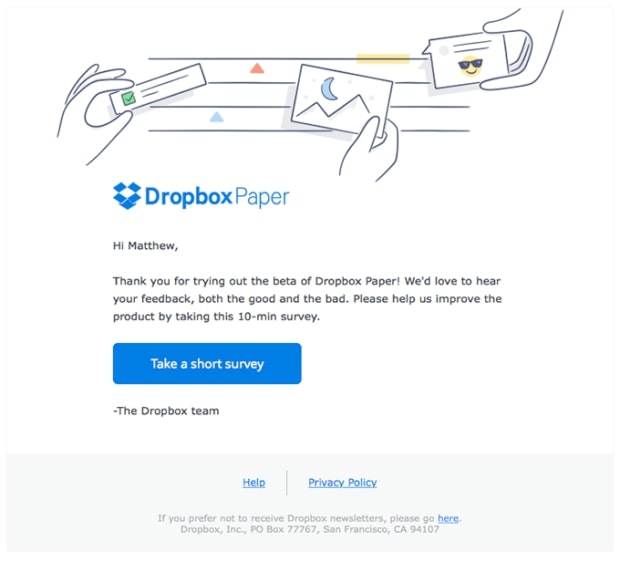
6. Holiday related emails
Holidays are a good time for businesses to reach out to their customers. Not only would you convey Christmas pleasantries, but you could also use it to generate more leads and increase sales.
You can highlight a gift or special deal that the subscriber can purchase by including a call-to-action button in your holiday email. Businesses can use holiday emails to reach out to customers and increase sales throughout the holiday season.
Birchbox’s Black Friday holiday offer is a nice example of a holiday email.
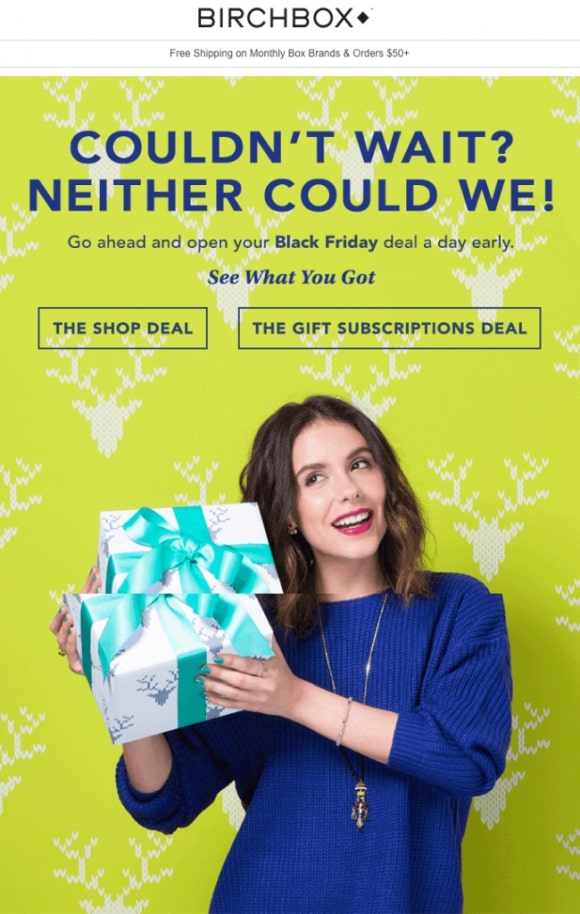
7. Post-purchase drip
Most companies do not send these types of emails. A basic follow-up to a purchase is a post-purchase drip. For example, suppose a consumer purchased a vacuum cleaner from you. You can send an email with advice on how to use and maintain the vacuum cleaner as part of your post-purchase drip campaign.
A post-purchase drip email’s goal is to establish trust and strengthen your relationship with the buyer. It is a valuable tool if you want to upsell or cross-sell a product in the future.
8. Re-engagement emails
Your email engagement is a critical indicator that affects your sender reputation. Inactive subscribers reduce overall engagement and have an influence on email delivery.
So, what should you do if your subscribers cease engaging with your content? You can re-engage them by sending them re-engagement emails. This is due to the fact that acquiring a new customer is 5 to 25 times more expensive than retaining an existing one. This is an example of a Webflow re-engagement email:
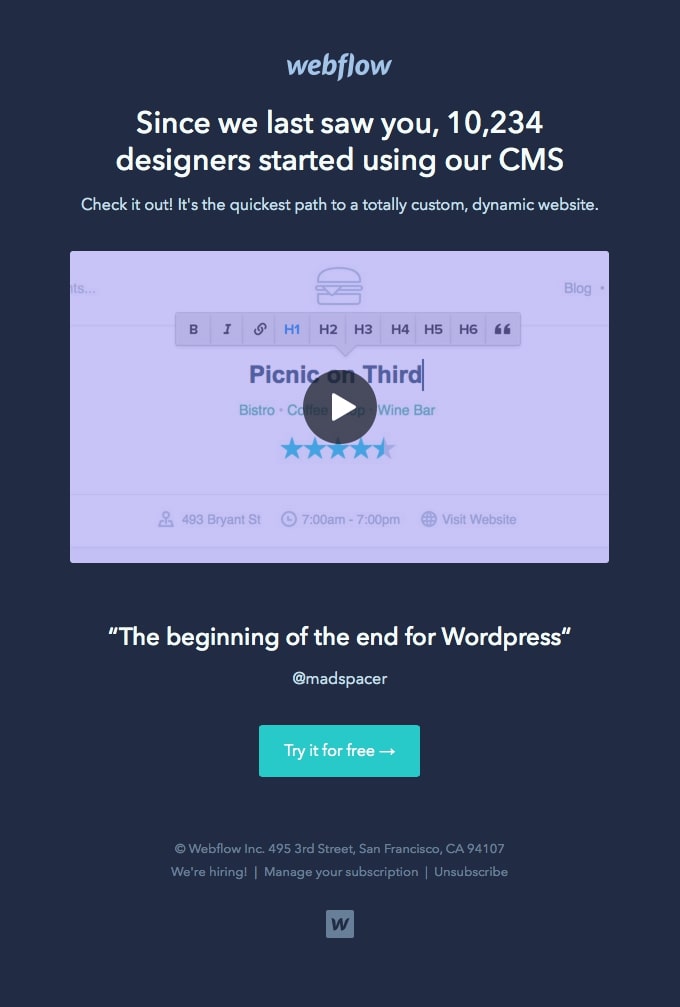
Webflow entices the user to begin using their product by sending a professionally designed email with appealing facts. The video also adds to the email’s appeal. That’s all! If you’re unsure about which types of emails to include in your plan, you can use the samples in this article as a starting point.
Best email marketing tool for small and medium-sized businesses

AVADA Marketing Automation is a multi-channel email and SMS marketing platform that can help you send all types of emails and run effective campaigns, so if you need a tool to help you handle your email marketing, try this one out. It’s a feature-rich and very affordable choice.
Final words
That’s it! I hope this article has provided you with valuable information about the differences between transactional and marketing emails. Please feel free to leave comments below for further discussion on this topic!
New Posts






